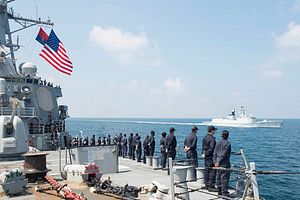On August 12, the People’s Liberation Army Navy (PLAN) and U.S. Navy held a number of naval drills including a Code for Unplanned Encounters at Sea (CUES), and a search-and-rescue (SAR) swimmer training event during a four-day port visit of the Arleigh-Burke-class guided-missile destroyer USS Benfold to the seaport of Qingdao, located on the Yellow Sea in China’s Shandong Province, U.S. Pacific Command reports.
The drills involved the USS Benfold and the PLAN’s 4,000-ton Type 054A Jiangkai II-class guided-missile frigate Daqing. The two ships exchanged two officers each, who acted as liaison and observed operations on their respective ship’s bridge. “We conducted several underway drills using CUES and communicated back and forth in both English and Mandarin between the two ships with PLAN officers on Benfold’s bridge,” the commanding officer of the USS Benfold, Commander Justin L. Harts, said.
CUES is a non-binding, voluntary agreement to regulate encounters of military forces at sea or in the air. It was signed by 25 countries at the biennial Western Pacific Naval Symposium (WPNS) in Qingdao, China in 2014. The navies of CUES signatory nations are expected to follow certain communications protocols when interacting with each other with the aim of avoiding miscalculations and misinterpretations of the other side’s intent.“CUES is a set of guidelines for unplanned maritime encounters with the aim of reducing incidences at sea, providing standards for communication, safety procedures and maneuvering instructions for naval ships and aircraft,” according to the U.S. Pacific Command.
During the exercise on August, both ships practiced tactical signals and the use of CUES when operating in close proximity to each other. “This engagement helped to strengthen our continued use of CUES in an effort to reinforce international norms when operating in close proximity to each other,” a U.S. Navy officer serving aboard the USS Benfold said. “With CUES in place, short of a few dangerous aerial maneuvers by Chinese fighters, we haven’t quite seen incidents at sea similar to USS Cowpens encounter with a People’s Liberation Army-Navy (PLAN) amphibious dock ship. Regarding the issue of unsafe aerial intercepts, the United States and China finalized bilateral rules for aerial encounters as well, building on CUES’ communication protocols,” my colleague Ankit Panda explained in January 2016.
The second part of the naval drill consisted of a joint search-and-rescue operation (SAR).” The final event in the engagement practiced search and rescue where both the Daqing and Benfold searched for, and rescued, simulated victims dropped by a PLA(N) support ship. Each ship independently spotted their simulated victim, maneuvered to recover, and deployed a small boat with a SAR swimmer onboard,” according to the U.S. Pacific Command press release.
The USS Benfold departed Qingdao, which is also the homeport of the People’s Liberation Army Navy (PLAN) North Sea Fleet, on August 12. The ship is currently cruising in the Western Pacific and is a member of the U.S. 7th Fleet’s so-called Forward Deployed Naval Forces based in Yokusuka, Japan. As I reported previously, the USS Benfold was the first U.S. warship to visit a Chinese port after the China-Philippines sea court ruling on certain maritime disputes between the two nations in the South China Sea in July.
The commander of the U.S. Pacific Fleet, Admiral Scott Swift, also paid an official visit to the PLAN North Sea Fleet headquarters on August 8 urging the PLAN to show more transparency about its intentions in the region (See: ”Top US Navy Officer in Asia Calls for Military Transparency in China Visit”). Swift underlined “the importance of transparency, parity and reciprocity in the effort to improve the relationship between the Pacific Fleet and the PLA(N),” in his meeting with North Sea Fleet commander, Vice Admiral Yuan Yubai, a U.S. Navy press release notes.

































